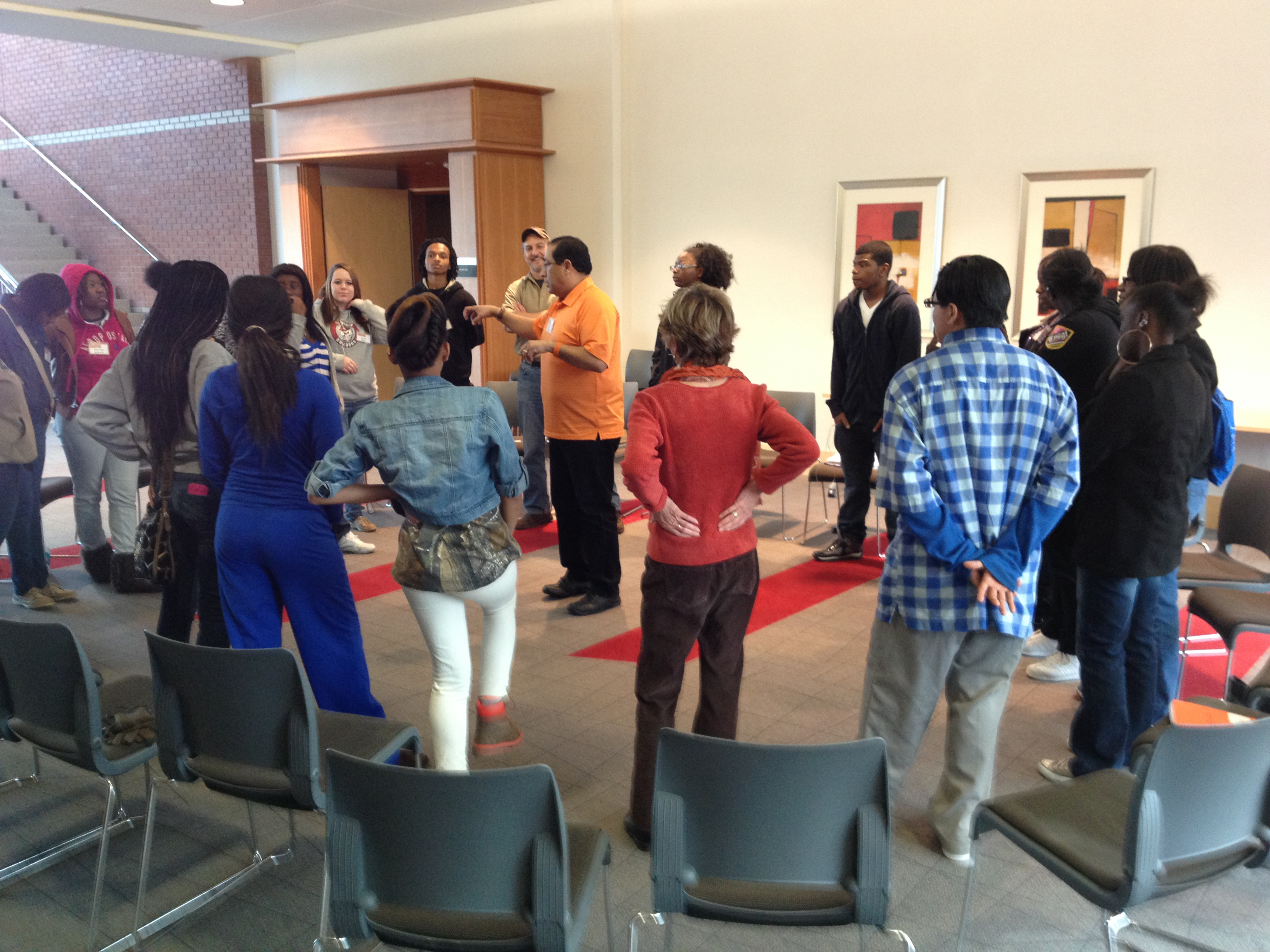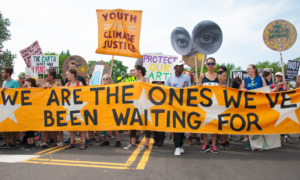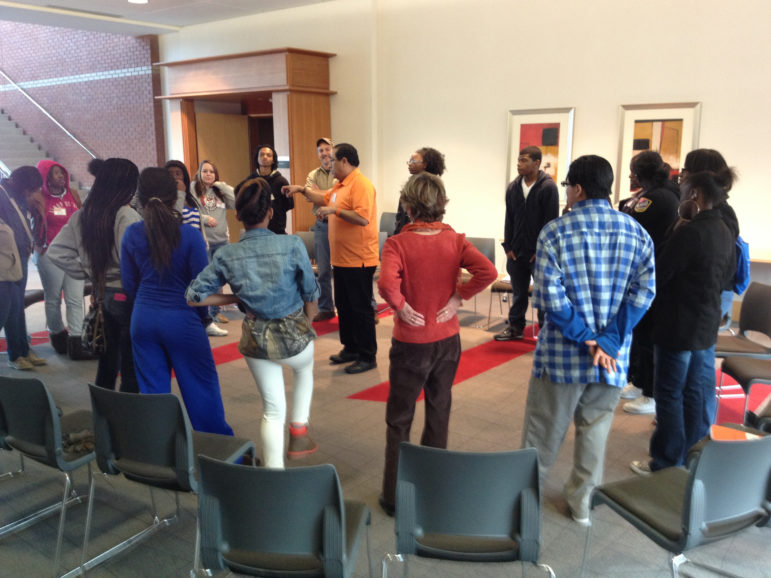
Photos courtesy of Orange Duffel Bag Initiative
Orange Duffel Bag Initiative’s 12-week program at Middle Georgia State University, in Macon, Georgia, opens with a session by Coach Luis Castro, leading high school participants through a circle activity, where they share personal stories and bold visions for the future.
At the after-school coaching programs run by the Orange Duffel Bag Initiative, the staff never shines a spotlight on the fact that many of their participants are homeless.
Rather, they wait for a teenager or young adult to open up.
Often the moment comes when the participants draw their chairs into a circle after a day of trust-building exercises. They talk about experiencing homeless, the foster care system or deep poverty.
The OBDI organizers know their backgrounds. Counselors, school homeless liaisons and group home staffers refer them to the program in the first place.
But it’s critical their stories remain their own until they decide the time is right to share, said Diana Black, vice-president of the initiative. When the participants feel comfortable being vulnerable, that’s when Orange Duffle Bag’s coaching aimed at education and employment success can take off.
“Anytime we can put voice to our reality, it strengthens us,” she said.
When homeless young person lead the way, out-of-school time (OST) staff can provide them with much needed support, regardless of who their program is geared toward, experts say.
In the often rough-and-tumble lives of youth who are experiencing homelessness, OST programs can be a welcome respite, said Barbara Duffield, director of policy and programs at the National Association for the Education of Homeless Children and Youth.
“It’s critically important when everything else is upside down that all the additional supports are out there,” she said.
There’s no perfect national data on youth homelessness. The Department of Education reports nearly 1.4 million U.S. students experienced homeless in 2014, most as part of a family.
More narrowly, federal data shows that about 45,000 children and youth without a parent or guardian under age 25 were living on the streets, in shelter or in transitional housing during a 2014 point-in-time survey, according to federal data. Most of those unaccompanied children and youth were older than 18 and younger than 25.
In addition, more than 90,000 unaccompanied youth enrolled in public school were identified as homeless during the 2013-14 school year, most of whom were under 18.
Research also shows that some youth and young adults are more vulnerable to homelessness, including former foster youth and lesbian, gay, bisexual and transgender youth. A federal survey released in April found about half of participants in street outreach programs had experienced the child welfare system.
The federal government has set an ambitious goal of ending youth homelessness by 2020.
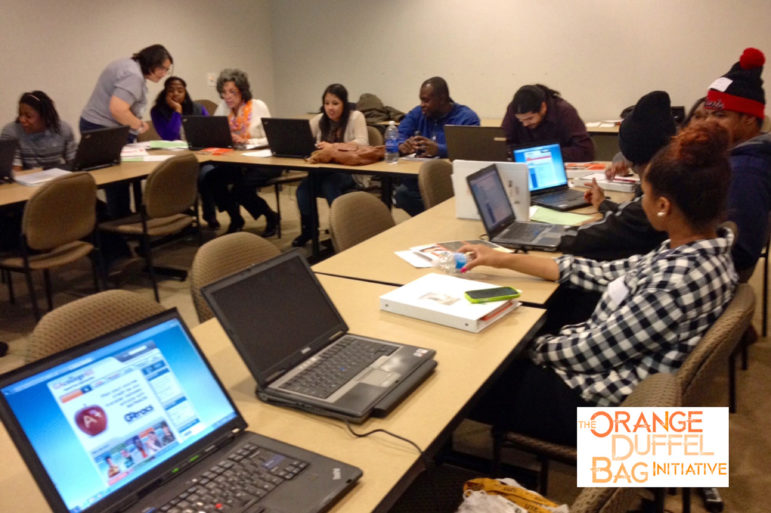
At ODBI’s 12-week after-school program at Kennesaw State University, high school participants use the computer lab to complete online college applications and get familiarized with Free Application for Federal Student Aid (FAFSA) and GACollege411, an online resource for prospective college students.
A role for OST
Youth are looking for people who care — a role that OST staff are primed to fill, said Catherine Heath, child and family program specialist at the federal Children’s Bureau. “We hear from young people all the time how important it was when an adult took an interest in their life.”
Social worker Sara Bowman helps teenagers and young adults move from foster care to adulthood without experiencing homelessness on the way.
And she loves to hit the OST jackpot — the moment when a tutor, mentor or other after-school program leader becomes part of a young person’s transition planning team.
“They’re the ones I get so amped up about and want to pull them in. They’re natural supporters who are going to be there,” said Bowman, the transitional planning facilitator at Thrive@25, an initiative on Maryland’s rural Eastern Shore (see sidebar).
Bowman brings together caseworkers, attorneys and family members who help teenagers or young adults plan their next moves. She said OST providers know young people’s strengths in tangible ways, such as how they learn or the activities that bring them joy. They can help a team think creatively about how a young person will secure housing, education and employment.
“They know the youth. They spend invaluable hours with them,” she said.
Structuring a program
Duffield says it’s critical to consider the needs of homeless youth before they even walk through the door.
Program leaders should think about their recruitment strategies and whether they’re likely to reach homeless young people. A call to a school homeless liaison may generate ideas about how to reach as broad a participant pool as possible.
Other barriers to participation may include transportation, supplies or even having a parent or guardian to sign an enrollment form. The more pitfalls staff can anticipate and plan for, the better off homeless youth will be, said Duffield.
Similarly, staff can plan for when a young person becomes homeless. Building a list of where rental assistance, food and temporary shelter can be found in a community is a useful way to start.
“Even before the question gets asked, find out if there are resources out there,” she said.
If a teenager or young adult does appear to be having housing trouble, the first step is to listen and to ask appropriate questions that help draw out whether a youth wants help and what kind of help they need, say practitioners and policymakers.
In some cases, teenagers may respond best to narrow questions, said Deborah Harburger, program director at The Institute for Innovation & Implementation at the University of Maryland School of Social Work, the lead partner for Thrive@25.
A teen may say “no” when asked if they’re homeless, because they know they can find a friend to stay with for a night or two.
Instead, more specific questions, such as “Where did you sleep last night?” or “Where will you sleep a week from now?” may prove more fruitful, said Harburger.
No matter an adult’s role, one key lesson is to encourage youth to share their stories and to treat them as individuals with aspirations and ideas, not problems to be fixed, said Harburger.
“They have a vision for themselves,” she said.
Resources:
The National Network for Youth, a membership organization that advocates at the federal level for homeless youth, publishes fact sheets, issue briefs and more at nn4youth.org.
“Opening Doors,” the federal strategic plan to end homelessness, details the government’s goal of preventing and ending youth homelessness by 2020, and is available at usich.gov/opening-doors.
The National Association for the Education of Homeless Children and Youth (naehcy.org) has a helpline for students and the adults in their lives who are navigating higher education enrollment and financial aid. Call 1-855-446-2673, text “NAEHCY” to 335577 or email highered@naehcy.org.
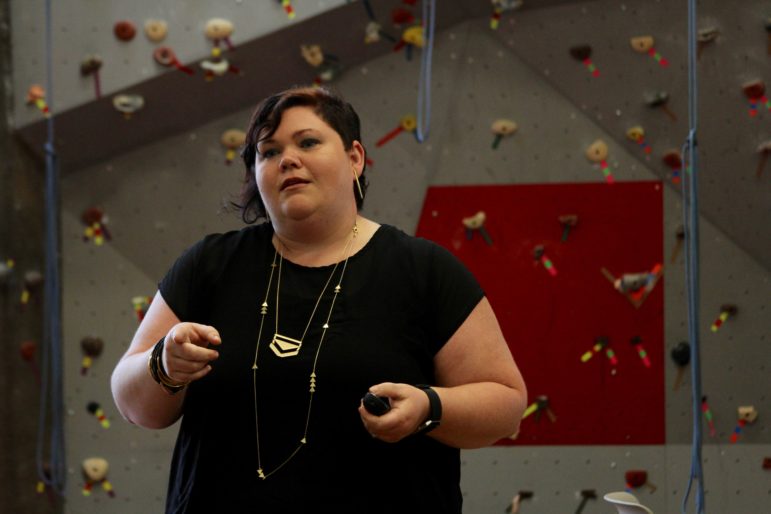
Photos by Sarah Barr
Marlene Matarese, training and technical assistance director at the Institute for Innovation and Implementation at the University of Maryland School of Social Work, leads a session about LGBT youth for Thrive@25.
Keeping the Door Open
Finding ways to prevent youth homelessness on Maryland’s rural Eastern Shore
When Xavia Palmer turned 19, she left her foster home on Maryland’s rural Eastern Shore for the suburbs of Washington, D.C., hoping to make it on her own.
She enrolled in an independent living program, found a job and started saving a small stash of money.
But a series of blows, especially a death in her family, left Palmer unsure of whether she could manage. She worried about paying the rent and struggled with the decision of whether to move in with family or friends.
Eventually, she spent months sleeping on friends’ couches, undermined by how little wiggle room she had to succeed as a young adult coming out of the foster care system. While Palmer had a supportive foster family, she said there’s still so much she didn’t know, especially about how to manage money.
“No matter how many resources you have or how much you planned, it’s still hard. The door shuts,” said Palmer, now 24, who today has a job she loves in customer service and shares a house with two roommates.
Now, an initiative in five counties on the Eastern Shore works to prevent other former foster youth from experiencing homelessness, whether that’s crashing on a different couch every night or sleeping on the street. Thrive@25 works with current and former foster youth to plan for the transition out of the child welfare system and into adulthood. And it’s one example of how practitioners and policymakers are trying to prevent and end youth homelessness by zeroing in on the factors that make it more likely a teenager or young adult will experience homelessness, such as experiencing the child welfare system.
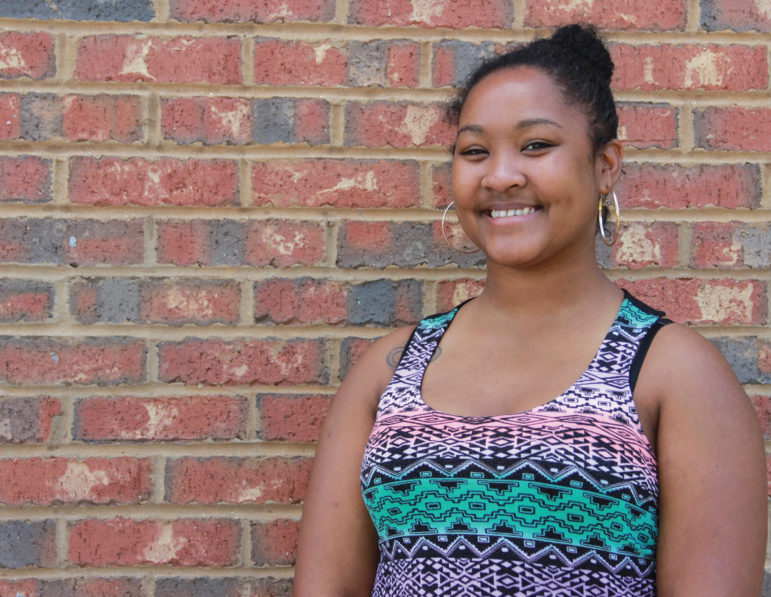
Photo by Sarah Barr
Xavia Palmer, who aged out of foster care on Maryland’s Eastern Shore, said young people need to know they can make a mistake and still have people and resources to rely on.
The problem isn’t that teenagers and young adults are being dumped on the street when they turn 18, but that they do not get comprehensive support that they can return to as they encounter bumps in the road, said Deborah Harburger, program director at The Institute for Innovation & Implementation at the University of Maryland School of Social Work, the lead partner for Thrive@25.
“The problem is the plan doesn’t always last. They don’t have the knowledge or resources to follow up,” she said.
Palmer, who was a youth advocate during the planning for Thrive@25, says teenagers and young adults have to be in charge of how their lives unfold. The initiative’s promise lies in making sure someone’s there when things get tough.
“We’ve got the youths’ back. We want them to know if they mess up, there’s somewhere they can go,” she said.
To help the federal government reach its goal of preventing and ending youth homelessness by 2020, policymakers are seeking a better understanding of why youth end up homeless and evidence-based interventions to prevent them from doing so.
That’s a new approach, one that’s essential to finding solutions, said Catherine Heath, a child and family program specialist at the Children’s Bureau within the federal Health and Human Services Department and the federal project officer for the grant that funds Thrive@25.
“It became very clear we know very little about youth homelessness. We provide a lot of services, but we don’t know much about what works,” she said.
Federal officials hope new programs will change that. For example, Thrive@25 is one of six sites nationally that will test an intervention program for youth aging out of the child welfare system, with the goal of gathering best practices that can be deployed in other communities.
On the Eastern Shore, officials are paying attention to what makes rural communities unique for teenagers and young adults at risk of homelessness, including limited job opportunities, fewer social service organizations than in urban areas and the lack of data showing how large the population of youth experiencing homeless is.
Thrive@25 will target three populations: foster youth who enter care between ages 14 and 17, foster youth ages 18 to 21, and homeless youth and young adults under 21 with child welfare history.
A dedicated transition planner will work with each participant and a team of family, mentors and officials to plan for the move out of foster care. When they encounter barriers, teams in the community will be available to brainstorm how to find or create new resources, said Emily Bradshaw, national wraparound coach and trainer at The Institute for Innovation & Implementation.
“Everyone makes mistakes and stumbles. The team is going to be come together and say, “How do we make this work?” Bradshaw said.


